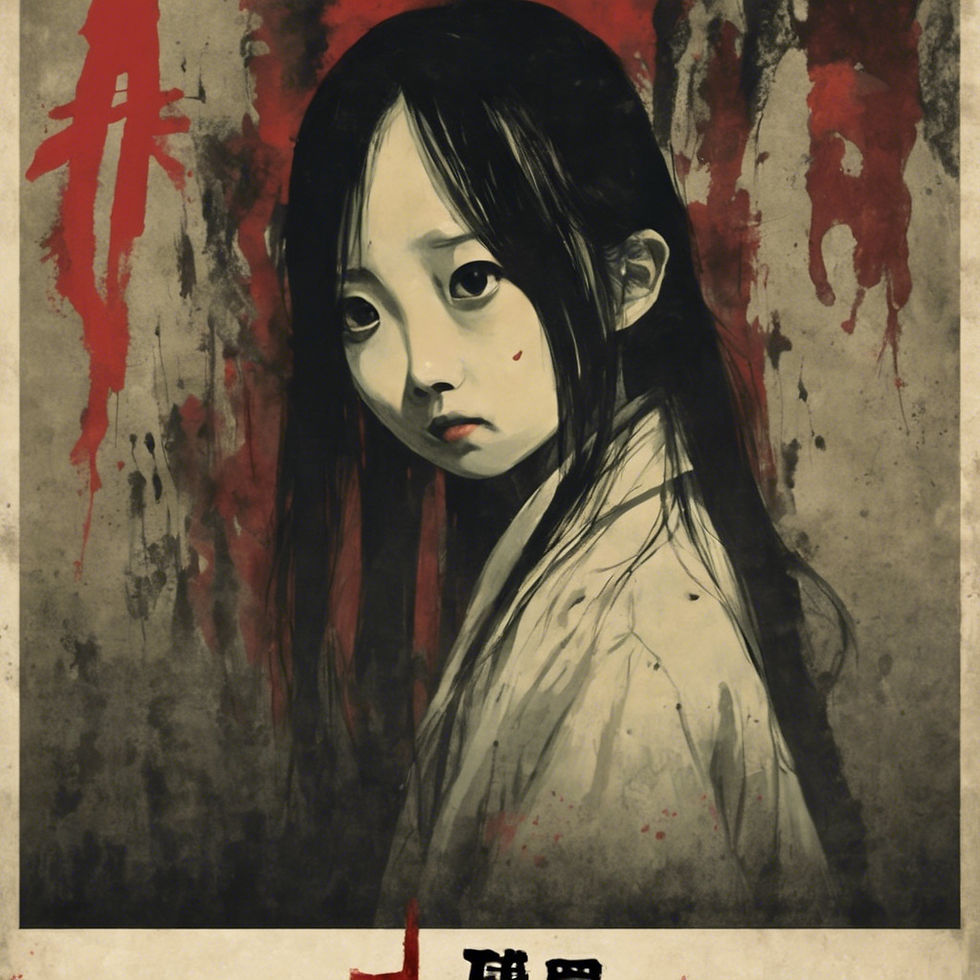‘ONRYOU’ IN ‘J – HORROR’ : A PORTAL TO THE POST WORLD-WAR SOCIOCULTURAL CONDITION OF WOMEN IN JAPAN. Part 1: Understanding J-Horror
- Sharmistha Chakrabartty

- Apr 18, 2024
- 4 min read
As a child I was a fan of Horror films. 3 of the most impactful films of my life was Dark Water, Grudge, Ringu. My understanding of J Horror is still limited, but here I am trying to share whatever I have learnt while exploring it. This will be a six-part blog post that would try to relate cinema, iconography of vengeful women spirit and the Japanese society post WWII. I had written this paper back in 2015, so it might not mention the new developments and films.

Whenever the tragedy strikes a society or it faces any sort of upheaval, the mass anxiety and fear get represented in the horror films through allegorical monsters and ghosts and metaphorical storylines. Horror is a reaction against or to the on-going norms of the society. It might be argued that stagnation in horror genre reflects a society stable and untouched by any mass sociopolitical, cultural or economic anxiety at the particular moment.
After Japan’s defeat in World War II and during the time of Allied Occupation, western democratic structure was imposed on Japan by the Allied Powers. This changed the political structure of Japan and created a society conflicted between traditional values and democratic structure. It created a tension in the society which manifested itself in the form of horror films.
The sociocultural anxieties of Japanese society has given birth to many masterpieces in genre of horror, like Gojira (1954), Ugetsu (1953) etc. However, none of them made its mark in Global Market or created a benchmark for cinematic horror in the minds of the foreign audience until early 2000s. Nakata’s Ring (1998) and Shimizu’s Ju-On : Grudge (2003), created a new milestone in the field of cinematic Horror. These two films and its remakes garnered international popularity and created a global interest for ‘Japanese horror cinema’ in particular and East Asian films in general.
Hideo Nakata’s Ringu and Dark Water and Shimizu Takashi’s Ju-on : Grudge have some similarities. Besides being the benchmark films for horror and having a US remake, these three films share a common motif, i.e. of ‘Wronged Women’, a term used in the book ‘Introduction to Japanese Horror Films’ by Colette Balmain. These 3 films give an insight into the prevalent socio – cultural condition of woman in Japanese society, in particular and social and economic anxieties of Japan after the sudden democratization, economic bubble and recession.
Before that, let's talk about horror as a genre.

Horror is a genre that is ever changing; its boundaries constantly shifting and merging with different genres. Horror is an “umbrella term”. It is a vast, complex, evolving and the most fluid genre with a plethora of sub genres and crossovers. The easiest way to define horror is “any film that shocked, scared, frightened, terrified, horrified, sickened, or disgusted, or which made the viewer shiver, get the goose bumps, shudder, tremble, jump, gasp or scream in fear could be classified as horror.”-Horror By Brigid Cherry. Horror is a paradoxical genre. It simultaneously repulses and attracts the audience through the monsters or entities that are principally unknowable and outsider. The core of every horror film is to present the natural anxieties in an unnatural form.

When we say Japanese Horror films, it encompasses every horror film that has been made in Japanese language under Japanese studio. We often abbreviate that into ‘J – Horror’. However the term ‘J Horror’ in narrowest sense means “relatively low budget horror films made in Japan during the late 1990s”. Ringu, Dark Water, Ju –on, Pulse etc. are some of the films which are mainly considered to be J horrors. Shimizu Takashi, Hideo Nakata, Kiyoshi Kurosawa etc. are some of the filmmakers associated with the production of these films. Most of the film makers of ‘J – horror’ were born in the same generation and were brought up in the same cultural environment and got inspired from similar artistic sources. Most of them were inspired by modern horror films of America and Europe, especially Slasher films. Shimizu was greatly inspired by films like ‘Friday the 13th’ and ‘A nightmare on Elm Street’. Later he took inspiration from these films while making his famous ‘Ju – on: Grudge’. In fact many ‘J – horror’ films are inspired from Hollywood films in terms of cinematic techniques while Hollywood take inspiration or rather remakes these films because of their rich plot. In terms of cinematic style, J – horror films have ‘low – key production’. The main emphasis is given on creation of psychological and atmospheric fear rather than gore. The stories are often based on urban legends like ‘Carved- the slit mouthed women’ or contains motifs, that are mostly exclusive to Japan, like the motif of ‘deceitful samurai’ ,‘wronged women’, ‘onryou – vengeful spirit’ etc. Japanese horror cinema was actually derived from ‘Kabuki’ theatre and ‘no’ theatre. In addition, The Shinto and Buddhist beliefs that speak about the existence of spirit world, and a rich mythology acted as the earliest breeding ground for horror stories in Japan. Japanese folk lore and fairy tales as well as contemporary situations also serve as the backdrop of these stories, like Kurosawa’s ‘Kairo’. However, at the core, ‘J Horror’ represents an on - going battle between the modern and pre – modern.
In the next post we will talk about, how the change in political structure of Japan during 1940s affected the films of 1990s.
To be continued...
Let's give credit where it is due. The books I referred to :
Cherry, Brigid. ‘Horror’, Routledge Taylor and Francis Group, New York, (2009)
‘Horror to the extreme’, Hong Kong University Press, Hong Kong, (2009).
McRoy, Jay, ‘Nightmare Japan’, Rodopi, New York, (2008).
Balmain, Colette, ‘Introduction to Japanese Horror films’. Edinburgh University Press, Great Britain, (2008)

Comentarios